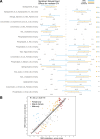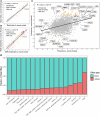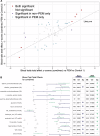Replicated blood-based biomarkers for myalgic encephalomyelitis not explicable by inactivity
- PMID: 40537675
- PMCID: PMC12254397
- DOI: 10.1038/s44321-025-00258-8
Replicated blood-based biomarkers for myalgic encephalomyelitis not explicable by inactivity
Abstract
Myalgic encephalomyelitis/chronic fatigue syndrome (ME/CFS) is a common female-biased disease. ME/CFS diagnosis is hindered by the absence of biomarkers that are unaffected by patients' low physical activity level. Our analysis used semi-parametric efficient estimators, an initial Super Learner fit followed by a one-step correction, three mediators, and natural direct and indirect estimands, to decompose the average effect of ME/CFS status on molecular and cellular traits. For this, we used UK Biobank data for up to 1455 ME/CFS cases and 131,303 controls. Hundreds of traits differed significantly between cases and controls, including 116 significant for both female and male cohorts. These were indicative of chronic inflammation, insulin resistance and liver disease. Nine of 14 traits were replicated in the smaller All-of-Us cohort. Results cannot be explained by restricted activity: via an activity mediator, ME/CFS status significantly affected only 1 of 3237 traits. Individuals with post-exertional malaise show stronger biomarker differences. Single traits could not cleanly distinguish cases from controls. Nevertheless, these results keep alive the future ambition of a blood-based biomarker panel for accurate ME/CFS diagnosis.
Keywords: All of Us Biobank; Myalgic Encephalomyelitis; Post-exertional Malaise; Semi-parametric Mediation Analysis; UK Biobank.
© 2025. The Author(s).
Conflict of interest statement
Disclosure and competing interests statement. The authors declare no competing interests.
Figures













References
-
- Benjamini Y, Hochberg Y (1995) Controlling the false discovery rate: a practical and powerful approach to multiple testing. J R Stat Soc Ser B (Methodol) 57:289–300
-
- Bickel PJ, Klaassen CAJ, Ritov Y, Wellner JA (1998) Efficient and adaptive estimation for semiparametric models. Springer New York
MeSH terms
Substances
Grants and funding
- n/a/ME Research UK
- MC_PC_20005/UKRI | Medical Research Council (MRC)
- MC_PC_20005/National Institute for Health and Care Research (NIHR)
- P/Y028856/1/Langmuir Talent Development Fellowship and philanthropic donation
- EP/Y028856/1/UKRI AI programme and the Engineering and Physical Sciences Research Council
LinkOut - more resources
Full Text Sources
Medical

